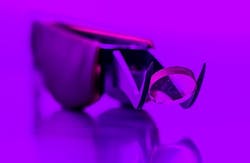Lawrence Livermore National Laboratory (Livermore, CA) scientists and academic collaborators have demonstrated the synthesis of transparent glass through 3D printing, a development that could ultimately lead to altering the design and structure of lasers and other devices that incorporate optics. The process is detailed in Advanced Materials.
RELATED ARTICLE: MIT molten-glass 3D printing makes complex optical components
Other research institutions have shown 3D printing of glass is possible, however prior demonstrations have involved extruding molten glass filaments through a heated print-head or using lasers to selectively melt and fuse glass powders. Lawrence Livermore's approach does not rely on printing molten glass; instead the researchers create custom inks that are formed from concentrated suspensions of glass particles with highly controlled flow properties so they can be printed at room temperature. The printed components then undergo a carefully designed thermal treatment to densify the parts and remove evidence of the printing process. Finally, the processed parts are given an optical quality polish. Researchers said the approach improves the odds of achieving optical uniformity.
"For printing high-quality optics, you shouldn't be able to see any pores and lines, they have to be transparent," said LLNL materials engineer Du Nguyen, who went through numerous mixtures of materials before finding the right combination. "Once we got a general formulation to work, we were able to tweak it so the material could merge during the printing process. Most other groups that have printed glass melt the glass first and cool it down later, which has the potential for residual stress and cracking. Because we print at room temperature, that's less of an issue."
LLNL's method uses a slurry of silica particles extruded through a direct-ink writing process. The printed product comes out opaque, but after drying and heat treatment becomes transparent. In contrast to 3D printing with molten glass, the researchers state, the approach doesn't require high temperatures during printing, thereby allowing for higher resolution features.
"Polishing complex or aspheric lenses is pretty labor-intensive and requires a lot of skill, but polishing a flat surface is much easier," Nguyen said. "By controlling the refractive index in the printed parts, you alter the bending of light, which enables a lens that could be polished flat."
Rather than replace traditional optics, researchers said they want to explore new applications with composition gradients that don't exist on the market today. Designing for novel optical components instead of using off-the-shelf optics could reduce the size, weight or cost of optics systems.
While the research could expand the design space for optical engineers, it also may have applications outside of optics, including glass microfluidic devices that have complex and previously unobtainable layouts, researchers said. Glass is a prized material for microfluidics due to its optical transparency, chemical resistance, mechanical properties and ability to tailor its surface chemistry and functionality. However, glass is difficult to machine and etch to make complex microfluidic device geometries feasible. The 3D printing of glass could change that, and the team demonstrated 3D printing of a simple microfluidic network.
Now that they've proved printing transparent glass is possible, researchers are turning their attention to making actual high-quality optics and gradient index lenses by varying the composition of the glass. The next hurdle is Gradient Refractive Index (GRIN) optics, which will require more process understanding and control.
SOURCE: Lawrence Livermore National Laboratory; https://www.llnl.gov/news/lab-breakthrough-3d-printing-glass

Gail Overton | Senior Editor (2004-2020)
Gail has more than 30 years of engineering, marketing, product management, and editorial experience in the photonics and optical communications industry. Before joining the staff at Laser Focus World in 2004, she held many product management and product marketing roles in the fiber-optics industry, most notably at Hughes (El Segundo, CA), GTE Labs (Waltham, MA), Corning (Corning, NY), Photon Kinetics (Beaverton, OR), and Newport Corporation (Irvine, CA). During her marketing career, Gail published articles in WDM Solutions and Sensors magazine and traveled internationally to conduct product and sales training. Gail received her BS degree in physics, with an emphasis in optics, from San Diego State University in San Diego, CA in May 1986.
